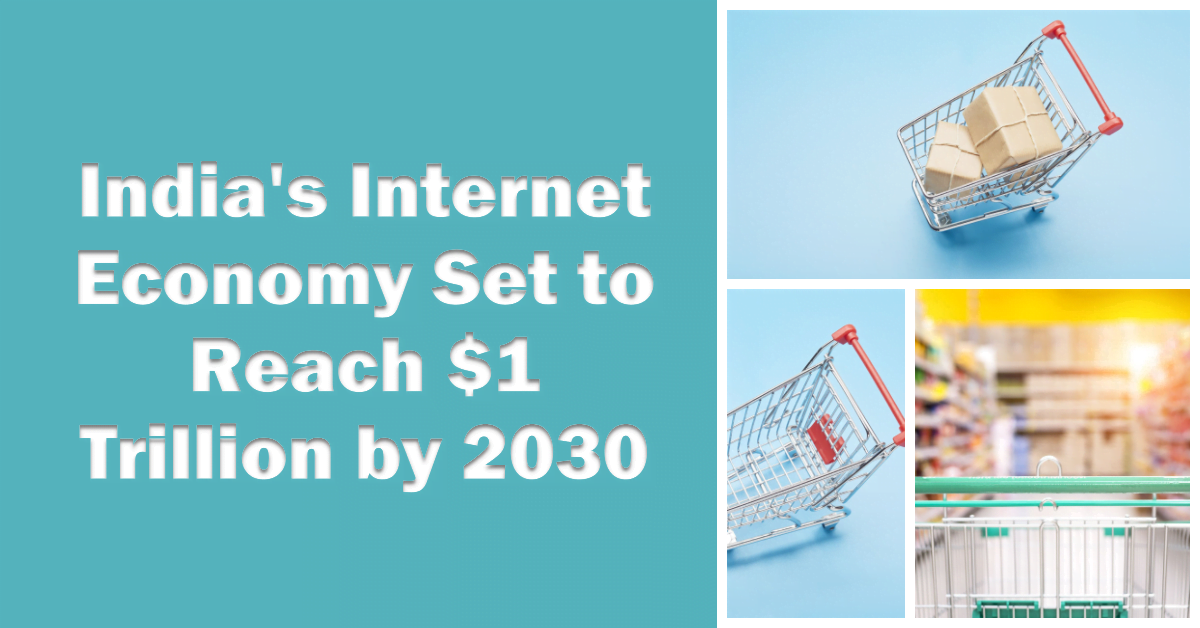A joint report by Google, Temasek, and Bain & Company predicts that India’s internet economy will experience an impressive six-fold growth, reaching $1 trillion by 2030. The report highlights the dominance of the B2C e-commerce sector, with other segments such as B2B e-commerce, software-as-a-service providers, and online media also contributing significantly to this growth.
India’s Internet Economy on Track for Monumental Growth
The report reveals a promising outlook for India’s internet economy, projecting a six-fold increase to $1 trillion by 2030.
This growth will be driven primarily by the thriving B2C e-commerce sector, followed closely by B2B e-commerce, software-as-a-service providers, and online media platforms led by over-the-top players.
Here’s a table summarising the key figures from the India’s internet economy
| Segment | 2022 Value (in USD billions) | Projected Growth by 2030 | Projected Value by 2030 (in USD billions) |
| B2C e-commerce | 60-65 | 5-6 times | 350-380 |
| B2B e-commerce | 8-9 | 13-14 times | 105-120 |
| Software-as-a-Service | 12-13 | 5-6 times | 65-75 |
| India’s Internet Economy (Total) | 155-175 | 6 times | 1,000 |
E-commerce Leading the Charge
The B2C e-commerce segment is expected to take center stage in India’s internet economy, expanding at a remarkable rate.
The report estimates a five to six-fold growth, soaring from approximately $60-65 billion in 2022 to a staggering $350-380 billion by 2030.
This surge reflects the increasing preference for digital purchases and the adoption of e-commerce platforms by Indian consumers.
B2B E-commerce: A Promising Frontier
While B2C e-commerce takes the spotlight, B2B e-commerce is not far behind in contributing to the overall growth of India’s internet economy.
The report forecasts a remarkable thirteen to fourteen-fold growth, with B2B e-commerce projected to reach $105-120 billion by 2030.
This surge indicates the rising demand for online business transactions and the shift towards digitization in the Indian market.
Unleashing the Potential of Software-as-a-Service
Another key player in India’s internet economy is the software-as-a-service (SaaS) segment. The report predicts a substantial five to six-fold growth in this sector, with SaaS expected to reach $65-75 billion by 2030.
The rise of cloud-based solutions, coupled with the increasing adoption of digital technologies, is driving the demand for SaaS providers in the country.
The Influence of Over-the-Top Players in Online Media
Online media, spearheaded by over-the-top (OTT) players, is also set to make a significant impact on India’s internet economy.
The report emphasizes the role of OTT platforms in driving the growth of this segment. As digital media consumption continues to rise, online media is projected to grow alongside other sectors, contributing to the overall growth of India’s internet economy.
Embracing Digital Transformation: Startups and Businesses Respond
According to Sanjay Gupta, Google India’s Country Manager & Vice President, startups have played a crucial role in driving digital innovation.
However, the report suggests that small and medium businesses, as well as large enterprises, are now embracing digital technologies to enhance their competitiveness.
The pandemic has accelerated this shift, prompting businesses to recognise the potential of digital platforms and services.
Frequently Asked Questions (FAQs):
What is the projected growth of India’s internet economy according to the report?
The report predicts that India’s internet economy will grow six-fold and reach $1 trillion by 2030.
Which sectors will drive the growth of India’s internet economy?
The growth of India’s internet economy will be primarily led by the B2C e-commerce segment. Additionally, B2B e-commerce, software-as-a-service providers, and online media platforms, particularly over-the-top players, will also contribute significantly to this growth.
How much is the B2C e-commerce sector expected to grow by 2030?
The report estimates that the B2C e-commerce sector will experience a five to six-fold growth, reaching $350-380 billion by 2030. This is a significant increase from approximately $60-65 billion in 2022.
What is the projected growth of the B2B e-commerce segment?
The report forecasts a thirteen to fourteen-fold growth for the B2B e-commerce segment, with a projected value of $105-120 billion by 2030. This indicates a substantial increase from around $8-9 billion in 2022.
How much growth is expected in the software-as-a-service (SaaS) segment?
The SaaS segment is projected to grow five to six times, reaching $65-75 billion by 2030. This is a significant rise from its value of $12-13 billion in 2022.
What role do over-the-top (OTT) players play in the growth of online media?
Over-the-top players, leading the online media segment, have a significant influence on the growth of India’s internet economy. Their platforms contribute to the overall expansion of the sector as digital media consumption continues to rise.
How has the pandemic influenced digital adoption among businesses?
The pandemic has accelerated the adoption of digital technologies by businesses. While startups have been at the forefront of digital innovation, small and medium businesses, as well as large enterprises, have recognized the need to leverage digital technologies to enhance their competitiveness.
How does the report reflect the shift towards digital purchases?
The report highlights the increasing preference for digital purchases in India. With the projected growth of the e-commerce sector, it indicates a significant shift from traditional retail to online platforms for consumers.
What factors are driving the growth of the software-as-a-service segment?
The growth of the software-as-a-service segment is driven by the rise of cloud-based solutions and the growing adoption of digital technologies across various industries in India.
What are the key contributors to India’s internet economy besides e-commerce?
In addition to e-commerce, B2B e-commerce, software-as-a-service providers, and online media led by over-the-top players are significant contributors to India’s internet economy’s projected growth.
Summary
In conclusion, the joint report by Google, Temasek, and Bain & Company paints a promising picture for India’s internet economy. With a projected growth of six times its current value, the industry is expected to reach $1 trillion by 2030. The dominance of e-commerce, along with the significant contributions from B2B e-commerce, software-as-a-service providers, and online media, highlights the country’s digital transformation and its potential for further development in the years to come.
You May Also Like
> The Growing Opportunities in the Indian Jewellery Retail Market

